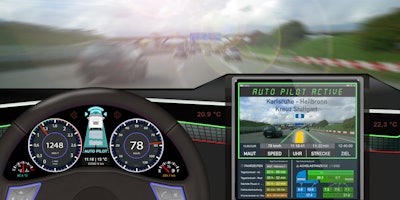
While online shopping is not a new trend, the pandemic brought it to new levels. According to Digital Commerce 360, online retail sales increased 32.4% year-over-year in 2020 and are up 39% in Q1 2021. For the food retail industry, the numbers are even more impactful. Prior to the Coronavirus disease (COVID-19), Gallup reported that 81% of consumers never bought groceries online. Fast forward to 2020 and the reverse is true, with 79% of consumers ordering online, according to Supermarket News. Furthermore, a recent study by Coresight Research demonstrates that 60% of consumers now buy their groceries online and will continue to do so as the pandemic recedes.
The exponential growth in e-commerce is bolstering last-mile deliveries and associated drivers, which include many individuals without previous commercial driving experience. In addition, recent regulatory measures are now bringing more technology into fleets. All of the current pressing factors are accelerating the demand for fleet management systems to go beyond vehicle tracking solutions to now include advancements in dashcams, driver monitoring, driver monitoring systems, external cameras and advanced driver assistance systems (ADAS).
Artificial intelligence (AI) has enhanced the capabilities of monitoring solutions across the automotive industry, including advancements in dashcams, driver monitoring, driver monitoring systems, external cameras and ADAS. AI offers a key to improving road safety, as it helps uncover driver behavior, traffic elements, vehicle movement and critical contextual data.
The rapid growth and countless benefits associated with this technology mean that the fleet management industry is expected to grow to $34 billion by 2025, at a compound annual growth rate (CAGR) of 11.3% during the forecast period, according to Markets and Markets.
To meet the demand, companies are racing to deliver software-defined cameras that have the ability to enable precision AI for video telematics, including forward collision, lane departure, pedestrian collision warnings, traffic sign recognition and stop-and-go assistance. AI cameras and enablement software also provide fleet operators with the benefit of increased cabin and driver road safety, reduced insurance costs and a shift from reactive to proactive safety incident management.
AI-based recommendations ensure that fleet drivers, managers and mechanics can make better decisions that improve the long-term performance of the fleet. AI can be trusted to understand driver behavior, traffic elements, vehicle movement and critical contextual data across driving ecosystems, but it only works if it can be successfully deployed in the vehicle to help drivers when it matters the most.
Telematics solutions enable fleet managers and the end customer to gain visibility of a vehicle’s location in real-time. Fleet managers can also establish the optimal route for drivers, add new jobs to the schedule and implement corrective actions to re-route a driver to avoid congestion or accidents. Better driving practices reduce vehicle maintenance requirements, and the system can alert vehicle owners about scheduled services to ensure that vehicle downtime can be planned around. All of these solutions contribute to lower operating costs and can maximize profits.
Telematics also delivers a monetary benefit through reduced insurance costs. According to data from Fleetio, over the last decade, insurance rates in the fleet industry have increased by 10-15% year-over-year. Having any accidents on your insurance policy will compound these expenses. Some of the primary considerations underwriters look at while issuing an insurance policy is your overall fleet safety record, compliance history and any safety measures your fleet takes. Details of this criteria include driver training programs, proper vehicle maintenance, implementation of telematics devices and fleet tracking systems, use of fleet safety technology, historical safety records and distracted driving incidents.
According to the National Highway Traffic Safety Administration (NHTSA), distracted driving is any activity that diverts attention from driving, whether it be texting, eating or adjusting the radio. According to NHTSA research, 9% of fatal crashes involved distracted driving in 2019, which resulted in 3,142 lives lost in crashes involving distracted drivers. As a result, U.S. senators are demanding improvements be made to promote automotive and traffic safety. A legislative package was recently re-introduced by Senators Edward J. Markey (D-Mass.) and Richard Blumenthal (D-Conn.), which includes the Stay Aware For Everyone (SAFE) Act. The SAFE Act focuses on distracted driving and will specifically require the DOT to study how driver-monitoring systems can prevent driver distraction, driver disengagement, automation complacency and the foreseeable misuse of advanced driver-assist systems. The legislation also requires a rulemaking to mandate the installation of driver-monitoring systems based on the results of this study, which shall incorporate appropriate privacy and data security safeguards.
Leveraging technology can also play a critical role in the promotion of distraction-free driving. Solutions like distracted driver management platforms, telematics devices and in-dash cameras are powerful tools for fleet managers. Pairing those with a fleet management software centralizes your critical fleet data to make analysis easier than ever.
Easy-to-use telematics technology fits any commercial vehicle for advanced vehicle tracking. With telematics software fleet managers gain total visibility of everything that happens on the road, including vehicle usage. They can also support drivers in the field with the right tools to keep them safe and make their jobs easier.
Telematics software can transform the e-commerce supply chain and customer experience, enabling the sector to reassure customers that they’re receiving a reliable, safe and cost-effective service.



















